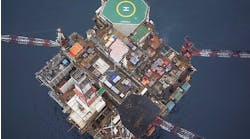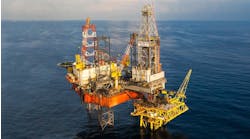Jeremy Beckman
London
Framo's subsea multiphase flow meter is the first of its type to operate in the UK North Sea. It has been operating successfully for nine months on Marathon's West Brae subsea manifold, measuring oil, water and gas flow rates, plus temperature and pressure from five West Brae wells exporting to the Brae A platform (8.5 km from the manifold).
Halliburton seeking command role
Halliburton has taken contracting to a new level by biding for operatorship of Amoco's North West Hutton oil and gas field. Halliburton already held equity in Monument's Fyne discovery, also on the UKCS, and Cairn's Sangu development off Bangladesh, but this would be its first stake in a producing offshore asset. The deal must first be ratified by the UK government.By selling its 26% interest, Amoco can allocate capital to new core UK projects rather than decommissioning of the NW Hutton platform. An 18-month study proved that the steel structure could be toppled via explosives, but in light of the Brent Spar's negative press, Amoco had sought to defer ignition.
Halliburton, which now takes on decommissioning liability, has explored several end-options of its own. It has the capability to mange the breakup in-house, terminating at a purpose-built site at Barmac's yard in Nigg, Scotland. But first, it wants to apply other facets of its expertise to enhance reservoir performance through to 2003.
The field began producing in 1983 through mid-Jurassic/Triassic and upper Jurassic horizons. Under-estimates of the reservoir's complexity led to a marked downgrading of recoverable oil, although prospects have swung back up of late following new evaluation studies by Schlumberger. According to analyts Wood Mackenzie, Halliburton has also tendered for an HP/HT semisubmersible to drill a development well, suggesting further upside potential for NW Hutton's gas and condensate.
A similar stay of execution was granted to the Dutch sector Kotter and Logger oil fields, this time transacted between bona fide oil companies. Clyde, a voracious accumulator of Netherlands interests, bought control of these fields from Conoco, plus related exploration acreage from the other participants. It is also believed to have gained a discounted cash sum towards future abandonment costs for the two fields, put at DFl 55-65 million by Wood MacKenzie.
Kotter and Logger came onstream in the mid-1980s in blocks K/18b and L/16a, exporting their oil by pipeline to Unocal's Q/1 facilities. Production was halted earlier this year, but will be resumed and prolonged by Clyde for at least three further years. Clyde can do this at a lower cost by using its infrastructure in this area. It may also exploit the platforms for tiebacks of some oil and gas prospects in adjoining blocks, due to be appraised from 1999.
Agip UK also wants to sell its Balmoral Field production semi, but then lease it back to the new owner on a field-life basis. The semi, with processing capacity of 100,000 b/d, currently extracts 12,000 b/d of oil from Balmoral and its Stirling/Glanis satellites. But production is due to wind down by 2001, with the current regime showing no enthusiasm for third party tiebacks. Agip is also listening to offers from developers of marginal fields, or contractors eyeing a conversion of the semi to a deepwater drilling unit.
"Token" production cut under review
Norway's self-imposed oil cut of 100,000 b/d, starting last month, is virtually a symbolic gesture, admitted Petroleum and Energy Deputy Minister Haaken Gill at OTC. If oil prices continue to fall, the cuts will be suspended, although for the time being, the government will monitor the situation on a monthly basis, he said. Cuts will apply to all producing Norwegian sector fields except for Statfjord and Murchison, which straddle the median line with the UK.Daily Norwegian output is expected to average out at 3.15 million bbl, he added, rising to a peak of 3.9 million b/d in 2001, before subsiding slowly to today's level in 2008. Norway's annual gas sales, however, look set to soar from 4 bcf/d currently to 7 bcf/d in 2005, nearly all of it exported to mainland Europe.
In the UK, the picture is clouded by the prolonged review of the petroleum tax regime. In response to detractors who claim that this is stifling new development activity, UK Energy Minister John Battle pointed out that it was the UK Offshore Operators Association which had requested a further delay for consultation. He also revealed that a record 186 UK offshore fields were in production last year, with projected remaining UKCS oil reserves of 2,015 million tons and outstanding gas of 1,985 bcm.
Newcomers sign up for Danish blocks
Agip won the acreage battle in the latest Danish licensing round, but awards (including some operatorships) also went to seven new entrants to the sector - Arco, Burlington, Kerr-McGee, Marathon, Saga, Samedan, and Veba. Interest has been heightened of late by the drilling successes of non-Danish companies Amerada Hess and Saga, which generated the current Arne South and Sirri field developments.Fifth round areas on offer were identical to those of the 4th round, opened in April 1995. Terms were broadly similar too, although this time, a sliding scale mechanism was to be imposed for closely contested blocks, allowing for increased state participation during the production phase.
The State lost out, however, because there were few bids for the same acreage. Where overlaps occurred, licence boundaries were negotiated amicably. Altogether, 17 licences were issued to 12 consortia over an area totaling around 6,340 sq km. That compares with nine licences and 4,200 sq km in 1995. Agip gained 11% of the awarded acreage, mostly in its 9/98 licence. Existing players in the Danish sector also fared well - among these, Enterprise and Donerco became first-time operators.
Trunkline pipelayers are grounded
Expansion of the Norwegian gas trunkline network is not going to plan this season. Laying of the Europipe II line from Kaarstoe, north of Stavanger to Dornum in Germany has been delayed by two months, due to protracted equipment tests on Allseas' new large diameter laybarge Solitaire.By now, though, the vessel should have mobilized to the Danish North Sea, from where it will begin laying the 42-in. line southwards. At the approaches to the German coast, the line will be tied to a section of pipe pre-installed in 1994, parallel with the existing Europipe I. From there, the vessel will transfer north to Vestre Boken island near Kaarstoe where the initiating secton of Europipe II will be pulled ashore, followed by resumption of laying south towards the Danish start point. The route out of Norway was recently lengthened for environmental reasons, by order of the Fisheries Ministry, but this should not delay first gas deliveries beyond October 1999, Statoil claims.
Solitaire's teething troubles also forced Allseas to cede the short Ekofisk bypass line (connecting Statpipe to the Norpipe system) to ETPM. However, a storm then pounded the latter's LB200 barge, causing its stinger and five mooring points to be lost. So ETPM was then obliged to ask its ex-venture partner McDermott for an early loan of the DLB 1601 barge, already committed this season to work on Elgin/Franklin and Shearwater in the UK sector. Repairs to the LB200 in Brest, France mean that Statoil also will have to endure delays to the Åsgardsgard Transport gas trunkline installation off Mid-Norway. Undeterred, Norske Shell has announced plans to pursue a new pipeline of its own in this area, tying in associated gas from its Draugen oil field into the Åsgard system.
Copyright 1998 Oil & Gas Journal. All Rights Reserved.


